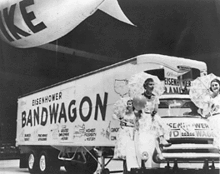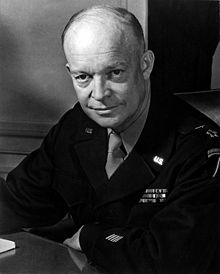- Draft Eisenhower movement
-
The Draft Eisenhower movement was the first successful political draft of the 20th century to take a private citizen to the Oval Office. It was a widespread American grassroots political movement that eventually persuaded Dwight D. Eisenhower to run for President. The movement culminated in the 1952 presidential election in which Eisenhower won the Republican nomination and defeated Democrat Adlai Stevenson to become the 34th President of the United States.
Contents
Eisenhower's rise to fame
Dwight Eisenhower enrolled at the United States Military Academy, West Point, New York, in June 1911, and graduated in 1915. He steadily rose through the ranks of the U.S. military from 1915 to 1952.
At the end of the War in Europe on May 8, 1945, Eisenhower had supreme command of all operational Allied forces. Eisenhower was named Chief of Staff of the U.S. Army in November 1945, and in December 1950 was named Supreme Commander of the North Atlantic Treaty Organization (NATO), and given operational command of NATO forces in Europe. Eisenhower retired from active service on May 31, 1952. During this period Eisenhower served as president of Columbia University from 1948 until 1953.
"I like Ike"
"Winter of Discontent"
 The caption for this 1952 photo, distributed by the National Citizens for Eisenhower, read in part, "The official Citizens for Eisenhower Bandwagon, one of six campaign vehicles now touring the nation, gets a send-off from three Ike girls just before it leaves San Francisco for its cross-country swing."
The caption for this 1952 photo, distributed by the National Citizens for Eisenhower, read in part, "The official Citizens for Eisenhower Bandwagon, one of six campaign vehicles now touring the nation, gets a send-off from three Ike girls just before it leaves San Francisco for its cross-country swing."
The time from 1951 to 1952 has been called the American "Winter of Discontent".[1] Americans were frustrated by the stalemated Korean War, with no clear end in sight, and unpopular President Harry S. Truman would not commit to seeking another term.
Draft Eisenhower movements had emerged ahead of the 1948 election, mostly in the Democratic Party; in July 1947 Truman offered to run as Eisenhower's running mate on the Democratic ticket if Douglas MacArthur won the Republican nomination.[2] The movements reemerged in 1951 in both the Republican and Democratic parties, as Eisenhower had not yet announced any political party affiliation. Eisenhower believed he needed to remain nonpartisan,[1] citing Army regulation 600-10.18.i forbidding partisan political activity by serving officers.[1] This did not stop Republican admirers from coining the phrase "I like Ike" (referring to "Ike", Eisenhower's nickname) in the spring of 1951 as a symbol of their hopes.[3]
The "I Like Ike" slogan was created when Peter G. Peterson of Market Facts (he would be Secretary of Commerce for Nixon), did research for the campaign and found out more people wanted to talk about how they trusted and felt comfortable with Ike, but didn't like to describe their views on all the issues. Thus, 'I Like Ike' went on all Ike paraphernalia.
Democrats sought a candidate who could help them retain the White House after Truman, who many felt could not win re-election. Hoping that Eisenhower would run on behalf of the Democratic Party, Truman wrote to Eisenhower in December 1951, saying: "I wish you would let me know what you intend to do." Eisenhower responded: "I do not feel that I have any duty to seek a political nomination."[1] Republican New York Governor Thomas E. Dewey and Senator Henry Cabot Lodge, Jr. of Massachusetts meanwhile worked to persuade him to run through an organization called "National Citizens for Eisenhower".
An alternative to Taft
Eisenhower eventually warmed to the Republican party, because he felt that the Democratic party was promoting centralized government at the expense of individual liberty. The internationalist wing of the party, in turn, saw Eisenhower as an alternative to the more isolationist candidate, Senator Robert A. Taft who, even up until the primaries, was widely considered by insiders to be the frontrunner for the nomination.[4] This contrast was also apparent in one of the larger national issues of the day: Communism. While Taft wanted to stop the spread of Communism by weeding out subversives in the homefront, Eisenhower focused on diplomatically containing the spread of Communism overseas.
Eisenhower hoped to settle the issue before taking the NATO post in Paris and met with Taft at the Pentagon in January 1951. He offered to make a Shermanesque statement rejecting any possibility of running for the presidency if Taft agreed to support collective security with Europe. Taft refused.[4][5]
By December 1951, the Draft Eisenhower movement had grown to the point that Eisenhower had his friend Clifford Roberts secretly organize a political advisory group of close, trusted persons to watch it.[1] Lodge was perhaps the most vocal, effective, and persistent supporter of the movement, and after months of argument, Lodge got Eisenhower to at least not repudiate a draft movement, though Eisenhower stated that he would never actively seek the nomination.[1] As momentum behind Taft's candidacy grew, Eisenhower's reluctance to run declined.[5] Early in 1952, just weeks before the start of the primary process, the movement finally got Eisenhower to admit that while he would not actively seek the nomination, he might respond if he truly felt called to a higher duty.[1]
The New Hampshire primary
On January 6, 1952, Lodge entered Eisenhower's name into the New Hampshire primary ballot without Eisenhower's permission. Afterward, Eisenhower finally stated that if offered the Republican nomination for the presidency, he would accept it. However, for several weeks, Eisenhower was a non-participant and would not speak out on his views or declare himself a candidate. Through January and February Eisenhower wrote to friends and family members saying that he was flattered by the movement, but did not really believe it was as widespread as the media implied.
On February 8 the movement demonstrated its size. A Draft Eisenhower rally was scheduled to be held in Madison Square Garden on that day. The event planners expected no more than the arena's 16,000-person capacity, but over 25,000 showed up, and the New York police and fire marshals could get very few people to leave. Then, on February 11, famous businesswoman and aviator Jacqueline Cochran flew to Paris to show Eisenhower Serenade to Ike, a tribute film she had made. The film visibly touched Eisenhower, who began to shed tears when, at the end of the film, Cochran toasted to Eisenhower, saying, "To the President of the United States." Eisenhower later wrote of the event, describing his inner turmoil by stating, "I've never been so upset in years."[1]
On March 11, 1952, Eisenhower won the New Hampshire primary against Taft[5] by 50% to 38% and captured all of the Republican delegates. Eisenhower announced that he was "astounded" and "moved" by the results and told a reporter, "Any American who would have that many other Americans pay him that compliment would be proud or he would not be an American."[1] After being convinced by this evidence, he announced his candidacy the next day.
Eisenhower won the Republican nomination and defeated Adlai Stevenson in the general election in November 1952.
References
- ^ a b c d e f g h i 50 Years Ago, Winter of Discontent, Winter 1951-52. The Eisenhower Institute. 2006.
- ^ "Truman Wrote of '48 Offer to Eisenhower" The New York Times, 11 July 2003.
- ^ Southern Review of Books, Vol. 7, No. 1, January 2009.
- ^ a b Ike Offers Not to Run for President. Dwight D. Eisenhower Memorial Commission. 2004.
- ^ a b c Immerman, Richard H. John Foster Dulles Lanham, Maryland: Rowman & Littlefield, 1998.
External links
- 1952 "I Like Ike" presidential campaign advertisement
- Papers of Leonard Burchman, Director of publicity, New York State Citizens for Eisenhower, Dwight D. Eisenhower Presidential Library
- Papers of Howard C. Petersen, finance chairman of the National Committee of Eisenhower for President, Dwight D. Eisenhower Presidential Library
- Papers of Ione Sutton, staff member of Citizens for Eisenhower, Dwight D. Eisenhower Presidential Library
Categories:- Defunct American political movements
- Dwight D. Eisenhower
Wikimedia Foundation. 2010.

